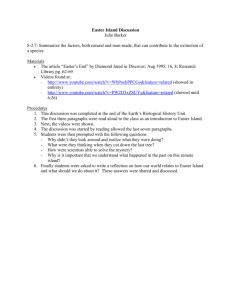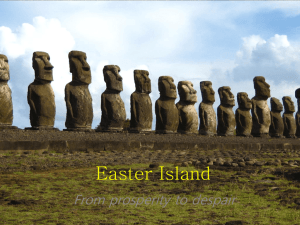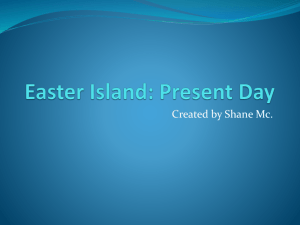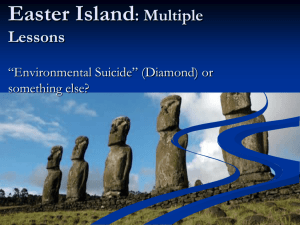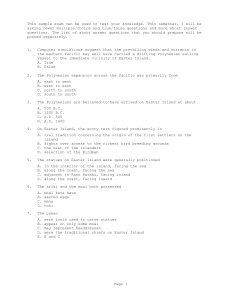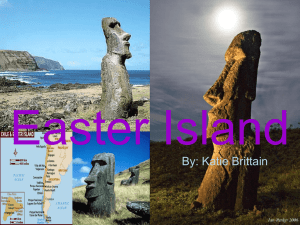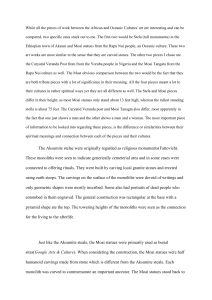On Easter Sunday, 1722 Easter Island was found and named by its
advertisement
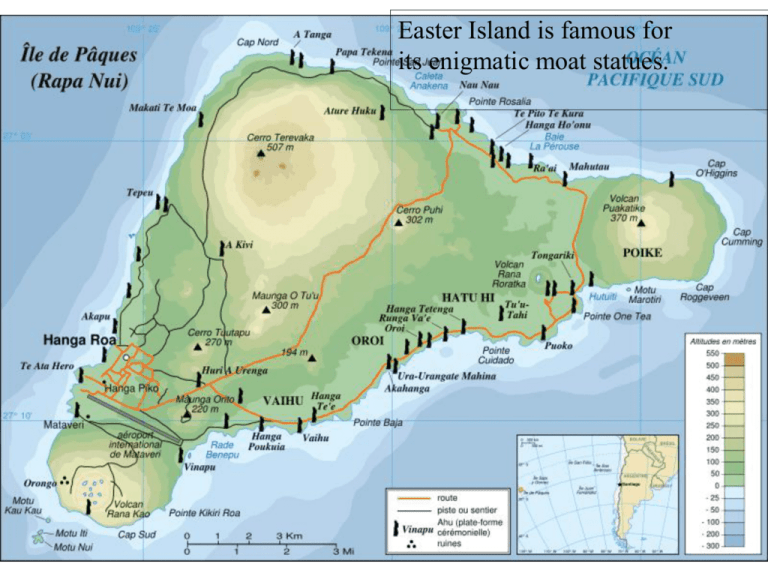
Easter Island is famous for its enigmatic moat statues. On Easter Sunday, 1722 Easter Island was found and named by its first recorded European visitor, the Dutch explorer Jacob Roggeveen.[ It is one of the most isolated islands in the world but 1200 years ago a double-hulled canoe filled with seafarers from a distant culture landed upon its shores. Located in the South Pacific between Chile and Tahiti, Easter Island is one of the most isolated inhabited islands in the world. Over the centuries that followed a remarkable society developed in isolation on the island. Its steep slopes, stood out like a beacon to a weary group of Polynesian seafarers. The people of Easter Island called themselves the Rapa Nui. Where did they come from and why did they disappear? In 1994, DNA from 12 Easter Island skeletons was found to be Polynesian. Ovahe Beach, North Shore This sheltered sand beach is close to Anakena, where the legends say King Hoto Matua landed his double hulled canoe, thus beginning the occupation of Easter Island. For reasons still unknown they began carving giant statues out of volcanic rock. These monuments, known, as "moai" are some of the most incredible ancient relics ever discovered. Roughly triangular and covering only 64 square miles, it formed when a plume of hot material rose from deep within Earth's interior, burned through the crust and erupted onto the surface as lava. The first islanders found a lush island, filled with giant palms which they used to build boats and houses. The plants they brought with them did well in the rich volcanic soil and by AD 1550 population on the island hit a high of between 7000 and 9000. Distinct clans formed as the population increased and various population centers grew up in different areas of the island. One thing tied them all together however — the statue construction and the cult that formed around it. It is unclear why the Easter Islanders turned to statue construction on such a massive scale. Their obsession with it ultimately brought about their downfall as they depleted more and more of the forests for use in the process of moving the giant moai. While the why is a mystery, where it happened and to a large degree how it happened is fairly clear. Each moai was born from the massive caldera of Rano Raraku. . While there are some other stone sculptures made by Polynesians, none is similar to the moai. In parts of South America, some statues have been found which resemble the "kneeling" statue on Rano Raraku, but nothing anywhere else resembles the standardized moai design that the Rapa Nui carved over a thousand times. The soft volcanic tuff was perfect material for statue carving. Using harder volcanic rock implements they were able to first sketch out the moai's outline in the rock wall and then systematically chip away at it until the moai was held in place by a thin "keel." Finally when a statue was finished, it was broken off its keel and slid carefully down the slope using ropes tied to giant palm trunks which were sunk in specially prepared holes in rim of the crater. At the base of the crater they were raised up and final decorations were carved into its torso and back. Coral and obsidian eyes were placed in as a final touch, although some suggest these were only placed in the statues on special occasions. Preparation was then made for transport across the island to various ahu. As evidence of the difficulty moving the moai, many can be seen along the paths of ancient roadways where they broke along the way and were abandoned. The moai carvers were master craftsmen that had rose through the ranks of a "carver's guild." The production of the statues was most likely through conscripted labor with many rituals and ceremonies performed throughout the process Once the statues were reasonably complete, they then had to be transported across the island to the platforms prepared for them. This involved a trek of 14 miles in some cases. Once the journey was complete the Moai were positioned atop great platforms called ahu. Built at the edge of the ocean, the ahu required just as much engineering know-how and raw labor as the statue construction itself. It is here that the Easter Islanders' stonework skills can fully be appreciated. The ahu platforms were Built with extreme Precision. This shot is a close up of the ahu above. These stone cutters were good! For decades the competition to build the biggest and best moai went on, and different ahu each belonging to a different clan - formed an almost unbroken line along the coast of Easter Island. The culture had reached its zenith. And then something went terribly wrong . . . A chilling story of resource exploitation and destruction on Easter Island is beginning to come to light. The first westerners to discover the island wondered how any one could have survived on such a desolate, treeless place. Indeed, this was a mystery until recent core samples taken from the crater lakes showed that the island was heavily forested with a giant now-extinct palm tree while the Easter Island culture was active. Apparently the islanders were greeted with a lush tropical paradise when they first discovered it. It must have seemed inexhaustible. The trees were cut for lumber for housing, wood for fires, and eventually for the rollers and lever-like devices used to move and erect the moai. As the deforestation continued the moai building competition turned into an obsession. The quarry was producing moai at sizes that probably could never have been moved very far (one unfinished moai in the quarry is 70 feet tall!) And still the trees came down. With the loss of the forests, the land began to erode. The small amount of topsoil quickly washed into the sea. The clans turned on one another in a battle for the scarce resources. The symbols of the islanders' power and success, the moai, were toppled. Eyes were smashed out of the moai and often rocks were placed where the statues neck would fall so it would decapitate the moai. The violence grew worse and worse. It was said that the victors would eat their dead enemies to gain strength, bones found on the island show evidence of this cannibalism. With the scarce food supplies it may have been a question of hunger as well as being ceremonial. A spooky cave at the southwest corner of the island, Ana Kai Tangata, is translated to "cave where men are eaten." Inside are pictographs painted in ochre and white of ghost like birds flying upwards. With no wood left to build boats, all the Rapa Nui people could do was look enviously at the birds that sail effortless through the sky. Their island was in shambles, and their villages and crops destroyed. There was no wood left on the island to build escape boats. The few survivors of the conflict, perhaps numbering as low as 750, began to pick up the pieces of their culture. One thing they left behind, however, were the moai.... One thing you half to wonder about? Who cut down the last tree? What possible motivation could there have been to deprive the Islanders’ of the last tree? If Easter Island was the only place on Earth to suffer at the hands of mankind run amuck, then we would not need to worry. BUT……..

